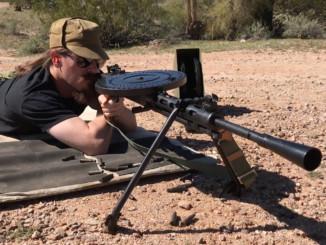The SR-3 Vikhr is mechanically based on the AS-VAL and VSS Vintorez rifles, but built to be a very compact personal defensive weapon instead of a silenced rifle. Still chambered for 9×39, the Vikhr is intended for roles like executive protection, where the priority is being compact and concealable. With elements like a top-folding minimalist stock and vz.61 Skorpion-like charging handle, the original model of SR-3 Vikhr fits this role pretty well. The later SR-3M model moved to a more traditional side-folding stock and regular charging handle.
Many thanks to the Royal Armouries for allowing me to film and disassemble this piece! The NFC collection there – perhaps the best military small arms collection in Western Europe – is available by appointment to researchers:
https://royalarmouries.org/research/national-firearms-centre/
You can browse the various Armouries collections online here:
https://royalarmouries.org/collection/




“(…)SR-3M model moved to a more traditional side-folding stock and regular charging handle.(…)”
It is composed from SR-3 parts and AS Val components. Beyond mentioned stock also fire-mode selector is same as in later. Important change is that SR-3M sports mount for optical sight, see 4th image from top https://modernfirearms.net/en/assault-rifles/russia-assault-rifles/sr-3-sr-3m-vihr-eng/
Magazines are interchangeable between Val and Vikhr and Vintorez. Following sizes are known to exists: 10, 20, 30.
If I were to hazard a guess, that “buffer” there at the very rear of the recoil spring assembly is there for two reasons: One, to prevent the top cover from making any noise that would be caused by it impacting the recoil spring guide, and two, to tension said top cover for consistency with regards to the rear sight position.
In all the various AK-type systems I’ve handled, particularly the Galil and the Valmet, that feature would have been a godsend. I’ve seen/heard of Finnish soldiers putting an improvised “gasket” made from bicycle innertube there at the back, in order to accomplish this. Not sure if the practice ever got to Israel or South Africa, but there ya go.
In South Africa it did. At least there were a series of all hands nastygrams from Command that came down saying “Stop doing that!”. My unit had R1s (FN FALs) so we just snickered and carried on.
That’s… Interesting. What time frame was this, and what was the rationale behind it? The Finn I knew who told me about this trick said they used either O-rings or a piece of innertube in order to silence the rattling, and tension the cover so that it reduced movement for the rear sight. From what he related, he’d been taught the technique by his actual instructors in the Border Guard and another force he served in after his initial conscription was over.
Never ceases to amaze me what the fussbudgets in the Ordnance departments of the world can get up to, when it comes to keeping their precious standardizations intact… The Canadians had their C7A2 rifles issued for years with the collapsible carbine buttstocks, but the US military refused to make that simple concession to common sense for everyone saddled with the M16A2, under the specious theory that the longer barrel and gas system didn’t work with a carbine-type buttstock. Arrant stupidity, but there you go… Anyone stuck with the damn M16A2 and having to work out of vehicles can feel the pain we all dealt with, trying to unass said vehicle and return fire. I’d be willing to bet that that “Keep them as they were issued” mentality cost at least a couple of people their lives, trying to cope with getting out of an uparmor HMMWV with said “musket” as their weapon… I know the damn thing nearly killed my ass doing the rollover drills in the simulator.
Time frame, 1980-1982. The rationale? In my memory it was one of those “It has come to our attention that you people are being naughty with our rifles. Stop it. And we really mean it this time!” As mentioned above it didn’t directly effect me or mine so I didn’t pay all that much attention.
Entirely on-brand for the usual control-freak inhabiting those realms of the military.
Swear to God, you would not believe some of the crap that the “authorities” would come up with, whenever someone made a suggestion on improving things or fixing a piece of equipment. And, usually after asking for “user feedback”.
Once upon a time, I was in the US Army’s 9th Infantry Division, that which was at the time labeled as the “High Technology Light Testbed”. Had the rocket scientists from Natick Labs come around, soliciting for “ideas”. One of our medics had rigged up this water bladder affair out of an IV kit and the guts from a wine box; had the whole thing neatly fitted into the top flap of the issue ALICE pack, and offered it up as a means of reducing heat injuries because the soldier could drink on the move while marching… Natick boffins all said it was a horrible idea, and unnecessary. Rejected it.
Ten years later, they were paying Camelbak for the proprietary rights to the same design to put into the MOLLE program. Go figure.
“(…)paying Camelbak for the proprietary rights to the same design to put into the MOLLE program. Go figure.”
Conclusion: before you invent anything inside U.S.A. find and get rights for fancy name like https://genius.com/Allan-sherman-chim-chim-cheree-lyrics
“Natick boffins all said it was a horrible idea, and unnecessary.” Are you sure it was Natick (NSRDEC att)? Natick doesn’t set requirements and doesn’t have approval over what goes in the field aside from MR of an already validated system TRADOC sets the requirements based on the needs of the soldier, whether real or imagined, and some elements such as CASCOM have a reputation of putting individual egos far and above those requirments. Natick, the PM shops, and AMC are just trying to meet those requirements as interpreted by TRADOC.